#mr. boynton and miss brooks
Explore tagged Tumblr posts
Text

Our Miss Brooks characters
There simply isn’t enough (or any!) Our Miss Brooks fan art! Here we have Walter, Harriet, Mr. Conklin, Mr. Boynton, Connie Brooks, Mr.s Davis, and Minerva
#classic tv#classic tv shows#our miss brooks#our miss brooks fan art#fan art#miss brooks#Connie brooks#mr Boynton#mr Conklin#Walter and Harriet#old Hollywood#eve Arden#richard créna#gale Gordon#Robert Rockwell#gloria McMillan#jane morgan#Connie and Phil#mr. boynton and miss brooks
0 notes
Text

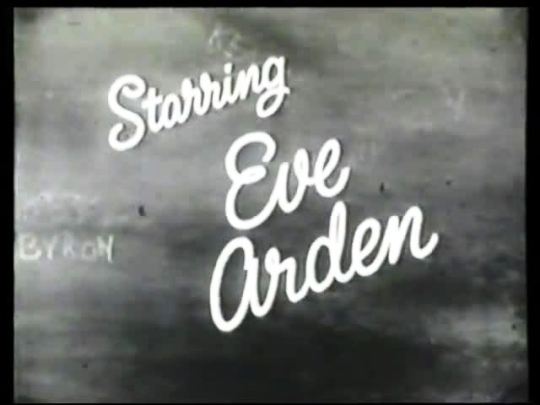

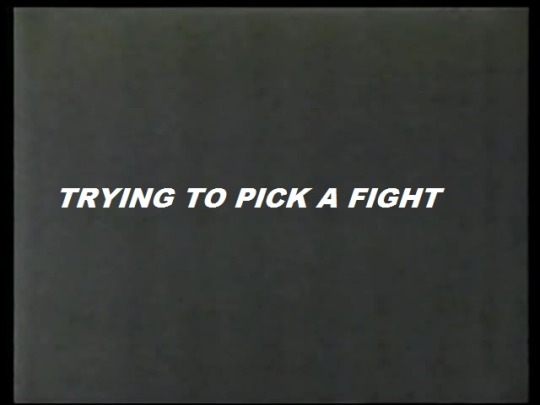

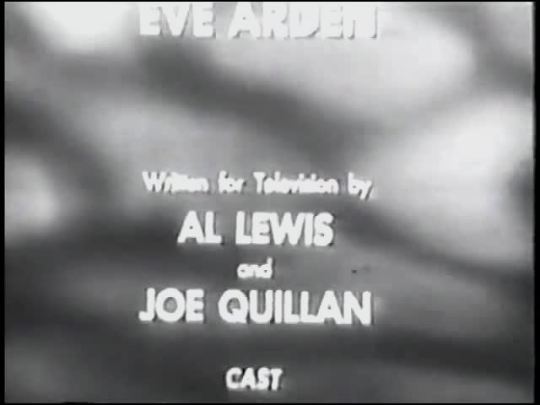
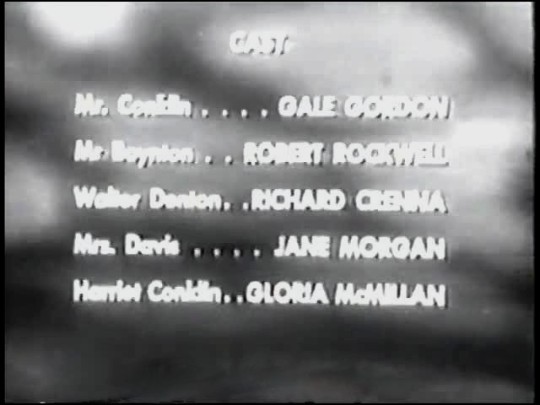






From the Golden Age of Television
Series Premiere
Our Miss Brooks - Trying to Pick a Fight - CBS - October 3, 1952
Sitcom
Running Time: 30 minutes
Directed by Al Lewis
Stars:
Eve Arden as Connie Brooks
Richard Crenna as Walter Denton
Gale Gordon as Osgood Conklin
Robert Rockwell as Philip Boynton
Jane Morgan as Mrs. Margaret Davis
Gloria McMillan as Harriet Conklin
Paula Winslowe as Martha Conklin (uncredited)
#Our Miss Brooks#TV#Premiere Episode#1952#CBS#Trying to Pick a Fight#Sitcom#Eve Arden#Richard Crenna#Gale Gordon#Robert Rockwell#Jane Moran#Gloria McMillan
5 notes
·
View notes
Text
LUCY UNIVERSITY!
Classes, Lessons & Other Tutorials

The Lucy character was one of the most inquisitve characters on television. A basic education did not prevent Lucy from furthering her education. Here are some lessons learned by Lucy!
HIGH SCHOOL
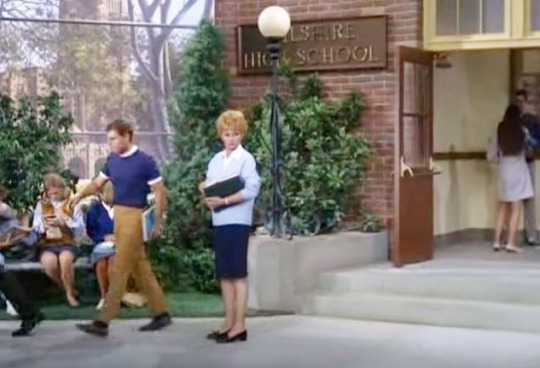
“Lucy Gets Her Diploma” (1967) ~ When Lucy Carmichael finds out the bank has a new policy of only employing high school graduates, she must go back to school to get her diploma in order to keep her job.
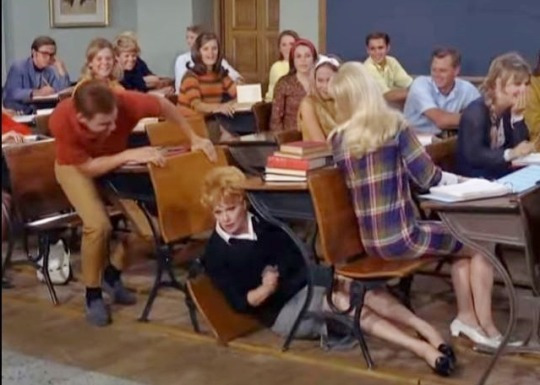
Lucy takes the usual classes - with a fair amount of physical comedy for extra credit. Her teachers include Dave Willock (Math), Donald Randolph (History), Olive Dunbar (Biology), and Barbara Babcock (English). The principal of Wilshire High School is played by George E. Carey.
MATH

“Liz Goes To Night School” (1950) ~ Liz's arithmetic skills are so bad, George sends her to night school where she somehow winds up in a math contest.
CHEMISTRY

“Lucy and Viv Take Up Chemistry” (1963) ~ Viv regrets letting Lucy talk her into joining her for a night school chemistry class. Lucy gets carried away trying to invent a youth serum and develops a huge ego between explosions. The frustrated biology teacher is played by Lou Krugman.

To teach her a lesson, Viv and the professor make her drink her own concoction. She’s horrified by the results of her youth formula.
AUTO MECHANICS

“The Not-So-Popular Mechanics” (1973) ~ Lucy Carter and Mary Jane take an adult school course in auto mechanics so they can change the oil on Harry’s vintage Rolls Royce. Their teacher is played by Robert Rockwell, who played biology teacher Mr. Boynton on “Our Miss Brooks” opposite Gale Gordon and Mary Jane Croft.
MUSIC

“Piano and Violin Lessons” (1949) ~ Liz takes up the piano to win a radio talent contest. To get even, George starts learning the violin. Who will win?

“The Benefit” (1952) ~ When Lucy wants to get into Ricky’s new act, she’s determined to improve her singing.

Lucy Carmichael was given singing lessons by Dr. Gitterman (Hans Conried) in “Lucy’s Barbershop Quartet” (1963). She used those same techniques on Agnes Schmidlap (aka Ethel Merman) when “Lucy Teaches Ethel Merman to Sing” (1964).
DANCE
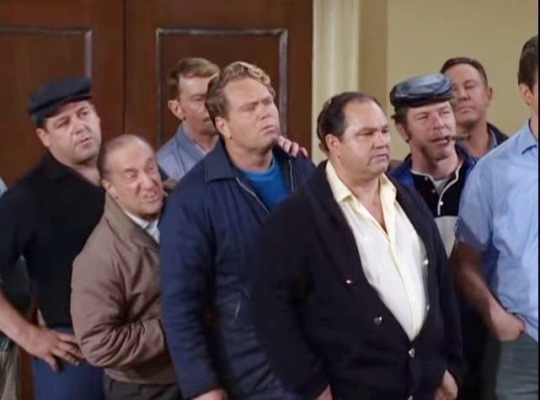
“Lucy Helps Ken Berry (1968) ~ Ken Jones (Berry) teaches a course of tap and soft shoe for $25. Lucy signs up and recruits a dozen truck drivers to participate - not your typical dance students.
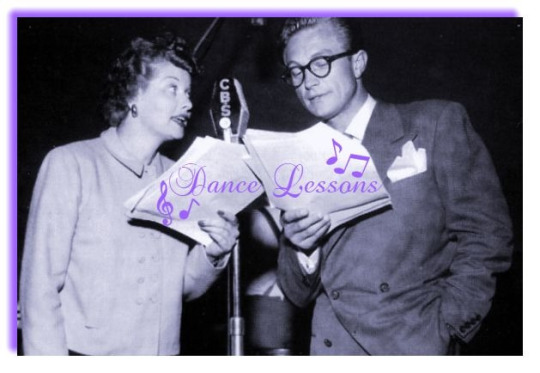
“Dance Lessons” (1950) ~ After a disastrous experience at a club dance, Liz and Iris send their husbands to Professor Crawford’s School of the Dance. Instead of being greeted by a befuddled old Professor, they meet his daughter, a breathless sexpot who immediately agrees to be their instructress.
RUDOLPH: “I’ve seen those girls who teach at Arthur Murray’s.”

“Liz Teaches Samba” (1950) ~ George talks Liz into teaching Wally, the son of the bank’s newest director, how to dance the Samba, and Wally gets a crush on Liz. The radio show served as the basis for...
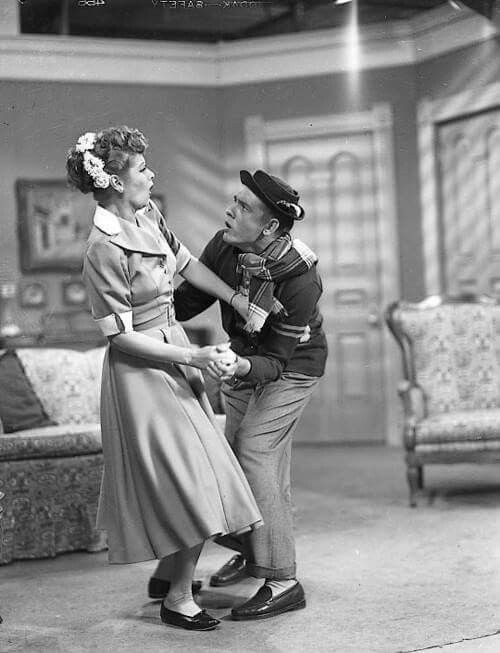
“The Young Fans” (1952) ~ Lucy gives private dance lessons to Arthur Morton (Richard Crenna) so he can better woo Peggy Dawson, but he turns out to be more attracted to Lucy.
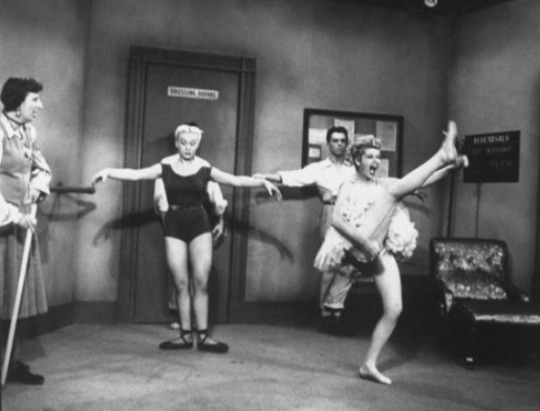
“The Ballet” (1952) ~ Thinking Ricky’s new act requires ballet, Lucy attends a class led by Madame LeMonde (Mary Wickes). “Abbas! Abbas!”

“The Adagio” (1952) ~ Fred teaches Lucy to do the Apache dance for Ricky’s new act. When Fred’s lessons prove unhelpful, Ethel suggests Jean Valjean Raymond (Shepard Menken), a Frenchman who is more interested in amour than apache. This episode was partly inspired by....
FRENCH

“The French Lessons” (1949) ~ Liz and Iris are humiliated when they can't read the menu at a French restaurant, so they decide to take French lessons. The lessons lead to the prospect of a duel between her favorite husband George and her amorous French teacher, Jacques Duval (Rolfe Sedan). The radio episode inspired...

“The French Revue” (1953) ~ A trip to a French restaurant makes Lucy think she should take French lessons from the waiter Robert DuBois (Alberto Morin) so she can take part in Ricky’s new show. Lucy later taught herself French when preparing for her trip to Europe.
DUBOIS: “In French, everything it is either masculine or feminine. You Americans don’t have that.” LUCY: “You haven’t been in this country very long, have you?”
ENGLISH

“The English Tutor” (1952) ~ So that her baby will be surrounded by proper elocation, diction and grammar, Lucy recruits tutor Percy Livermore (Hans Conried) to teach them how to speak properly - for free. Naturally, he has ulterior motives.
LIVERMORE (to Ricky): In lieu of the remuneration for my tutelage, I am to be permitted to introduce my talents into your nocturnal bistro.
ART

“Lucy Goes To Art Class” (1964) ~ To impress handsome bachelor John Brooks (Robert Alda) Lucy and Viv join him at an art class. The art teacher is played by John Carridine.
BROOKS: “I do believe that all of us have some sort of creativity bottled up inside of us.” LUCY: “I think this class might be just the thing to pop my cork!”

“Lucy and Uncle Harry’s Pot” (1973) ~ When Lucy breaks a vase which has great sentimental value to Harry, she goes to a ceramics class to make him a new one – with dubious results! Her teacher is played by Roger Twedt, an actual high school art teacher from Palm Springs.
ACTING

“Lucy Meets Mickey Rooney” (1966) ~ Mickey Rooney takes out a loan from Mr. Mooney's bank to open an acting school. Lucy and Mooney each wangle free acting lessons.
EQUESTRIANISM

“Horseback Riding” (1949) ~ George’s female co-chair for his horseback riding club’s upcoming breakfast ride has Liz so jealous that she’s determined to overcome her fear of horses and learn to ride herself.
COLLEGE

Fictional Pottawatomie College in New Mexico is the setting of Too Many Girls (1939), the film in which Lucille Ball first met Desi Arnaz, although their characters never meet on screen.
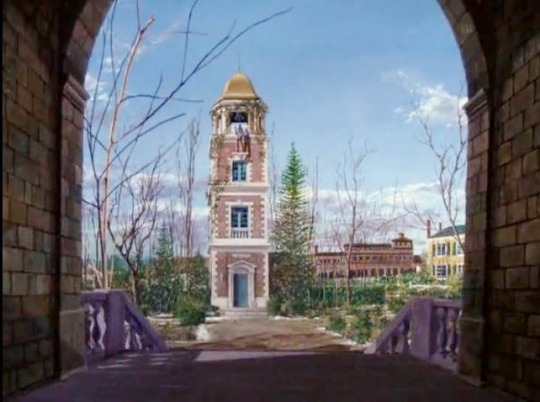
“Lucy’s College Reunion” (1963) ~ Lucy Carmichael (nee Taylor) goes back to her alumnus, Milroy College.
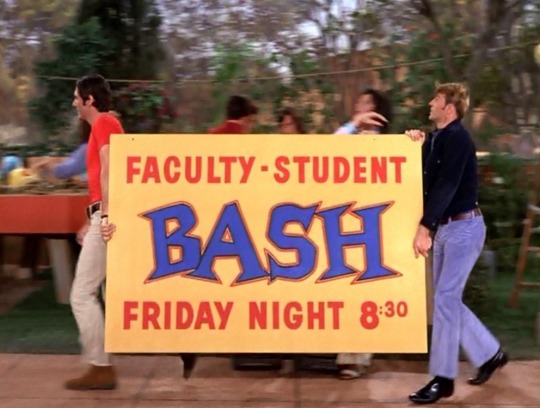
“Lucy and the Professor” (1973) ~ Lucy hears her daughter is dating an older man, so she goes to Kim’s college to see for herself. Unfortunately, Lucy mistakes an elderly professor (Murray Matheson) for the younger one (John Davidson) that Kim is actually dating!
PROFESSOR KLEINDORF: ”Thanks Professor Dietrich. You’re really groovy.” PROFESSOR DIETRICH: (points to his frown lines) “These aren’t grooves. They’re wrinkles.”

At Desilu Studios, Lucy opened the Desilu Playhouse, recruiting promising young performers to practice their craft under her tutelage, much in the same way Lela Rogers taught her at RKO. Some of the more famous graduates were Robert Osborne, Carole Cook, and Majel Barrett.

In the early 1980s Lucille Ball become Professor Ball, lecturing on comedy at UCLA.
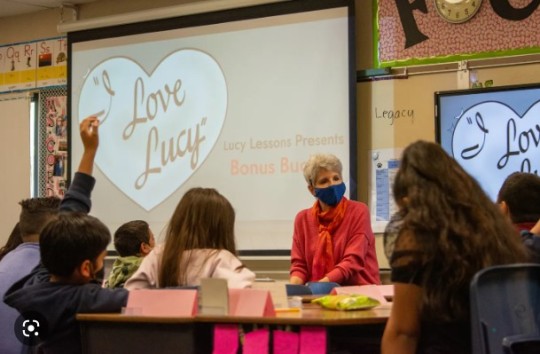
Grade school students listen to Lucie Arnaz talk during Lucy Lessons, educational modules built around episodes of “I Love Lucy.”
#Lucille Ball#I Love Lucy#My Favorite Husband#The Lucy Show#Here's Lucy#College#University#School#Lessons#Lectures#High School#Lucie Arnaz#Vivian Vance#William Frawley#Desi Arnaz#Mickey Rooney#John Carradine#Robert Alda#Hans Conried#Robert Rockwell#TV#Too Many Girls#Richard Crenna
2 notes
·
View notes
Text

100+ Films of 1952
Film number 134: Just for You
Release date: September 1st, 1952
Studio: Paramount
Genre: musical
Director: Elliott Nugent
Producer: Pat Duggan
Actors: Bing Crosby, Jane Wyman, Ethel Barrymore, Natalie Wood
Plot Summary: Jordan Blake, a famous Broadway Producer, is an only father to a teenage son and daughter, but his work prevents him from spending much time with them. Feeling guilty, he decides to take them on a trip to the country. This unfortunately requires him to leave behind his girlfriend, Carolina, an actress in his current show.
My Rating (out of five stars): **¾
I knew watching this many films from a less than stellar year in Hollywood would necessitate scraping the barrel, and boy was I right! I’ve seen more aggressively “meh” movies in the last few months than in my entire life previously! Case in point: this completely forgettable musical. I love musicals, and I love pretty much every actor in the cast... but there’s not much any of them can do with this material. It’s not a bad movie, it’s just... meh. (minor spoilers)
The Good:
The cast in general had a lot of talent. Crosby? Wyman? Barrymore? Wood? It’d be hard to assemble anything better for a mid-budget movie.
There was quite a bit of music in it, and I always prefer those kinds of musicals.
The vocals were all very good. Obviously, Crosby can sing the shit out of anything, even when he’s just phoning it in. I actually had no idea Jane Wyman sang, because I’ve only known her from melodramas and family-fare. She can really sing, though, and her voice, while not outstanding, is quite good. I liked its warmer lower register- it was well suited to swingy stuff.
When I heard this was about a father and his kids, I expected actual children would be in it. I was pleasantly surprised to see that both were teenagers, which made for more dramatic complexity.
There was a four-second cameo by the actor who played Mr. Boynton on Our Miss Brooks! It would be more likely missed than seen, however!
The Bad:
The music was pretty forgettable. I remember the “Zing a Little Zong” song that was the ostensible showpiece, but I can’t even remember the title song, and I just watched the movie.
The musical numbers were not staged well- they were shot about as memorably or interestingly as the songs themselves. Blah.
Here’s another Hollywood trope- musical numbers that are supposed to be happening on a theater stage that could never be on stage in real life. Here there were two egregious ones- a special effects number with Jane Wyman singing to her real time reflection in a mirror, and a Latin themed one that could only have made sense on a soundstage.
The story was kinda boring as well. It was pretty low stakes and predictable. Can a father bond more with his children? Can his son stop crushing on his girlfriend?
Brownface. In the above Latin themed number, it was clearly composed of white actors in brown makeup.
There was a random weird “Native American”?? themed song sung by girls at a summer camp. The song itself certainly didn’t sound Native in any way, but it was accompanied by a girl wearing a feather headband and lots of weird dancing with “Indian signs?” It wasn’t horribly offensive exactly... It was just weird and uncomfortable.
The ending was abrupt and poorly plotted. Was it trying to get patriotic all of the sudden? I honestly don’t know.
#1952#1952 movies#100 films of 1952#bing crosby#jane wyman#200 films of 1952#200 films of 1952 film 134
1 note
·
View note
Text
Episode 340 - Jeff Chandler (Part 3)
Silver-haired star Jeff Chandler takes his final bow on Suspense in "A Good Neighbor" (originally aired on CBS on March 31, 1957). Chandler stars as a thief who's trying to lay low after a heist, but a nosy neighbor may discover his secret. Plus we'll hear Chandler in his two signature radio roles. First he's the bashful biology teacher Mr. Boynton in Our Miss Brooks (originally aired on CBS on February 20, 1949), and then as private eye Michael Shayne he solves "The Case of the Model Murder."
Check out this episode!
0 notes
Text
1826 Thursday 20 April
6 55/60
11 10/60
Incurred a cross last night thinking of Pi [Mariana] - From 8 to 9 read from page 60 to 125 Dr Clark on the climate and diseases of the south of France and Italy - Letter from M- (Scarbro’) 3 pages - her sister will not go to York while Dr and Mrs Belcombe etc pay their visit at Boynton - little Offley Crewe and Watson cannot therefore be left in York - Can they be here - Went up to my aunt about it - yes! they can but not very conveniently - I thought M- had best send them home, but left her to do what she deemed best, begging her to let me know her determination as soon as she could for they must sleep in my uncle’s room (the kitchen now too hot) and it would require some preparation - Said we had given up all thought of going to Northgate and to Buxton - Should leave England 4 or 5 weeks sooner than we had thought of before - should stay here till after the rent day, and perhaps be far on our journey the middle of August (instead of being at Buxton) - wished to tell all this message to Mrs Norcliffe and the Duffins - M- to say nothing more than that we did not go to Northgate - Did not hint where we think of going - she says ‘I hope you have done right by explaining to Steph and Harriet the misunderstanding between you and my mother - I take much you do on trust, and must do it in this instance, for I do not know their reasons’....replied I was glad she was willing to take me on trust did not like mysteries and would have as few of them as possible ‘I act from the dictate of my conscience, of feel as if that ‘stout-siding champion’ would bear me out’ - She seems very ‘nervous’ at the thought of our going - bid her not be so - bad her set her mind at ease - promise to make her at least comfortable when she comes, and assure her she will find little fault with the person or plans of hers verily especially and entirely - A kind letter but I know she will be nervous about our going and particularly now that the time is hastened -
George took my note to Mr Freeman (Southowram lodge) before breakfast and brought me one back to say he was engaged today, but would call this week - Breakfast at 11 - Sent off my letter to M- (Dr Belcombe’s, King Street, Scarbro’) said I would do as she liked about meeting her in York - Went out at 12 - Mosey has sent his companion to set stoops and will come himself tomorrow - one (perhaps the 2 young men) gas-tarring the railing along the top of the wood at the bottom of Charles Howarth’s little Ing or acre field - James Sykes went to Huddersfield, Mirfield, and Dalton yesterday but could get no hollys except 50 of one of his brothers - planted them out today along the bit we have taken from the Tillyholme to put to the Lower brook Ing wood - Told him to go to Pontefract tomorrow (he can go one day and return the next) to see if he can get 1500 hollys there - to tell Jackman to come early tomorrow morning to speak to me about Northgate -
Sauntered up and down the walk - fell almost asleep under the sycamore I call my summer house overhanging the brook - delightful day - warm, but plenty of air, or wind - thought of our journey, and of M- to tell Steph before her and Harriet too if it so happens that if Pi [Mariana] cannot stay with delta [Charles Lawton] I wish her to have a small lodging and live quietly in York where all the world can see her good conduct I will make business to come to England at the first succeeding rent day and take her back with me -
Came in at 3 - talked a few minutes to my aunt then came upstairs and wrote all the above of today - As to our plans, told my aunt yesterday we would leave here the Monday after the rentday - on Monday 10 July - go to Paris - thence, staying a few days en passant at Fontainebleu, to Nenchatel (en Suisse) on account of Madame Carbonier who may perhaps be of use to us, and cross the Simplon in September to winter at Florence - we can pass the summer next year in the neighbourhood of the lake of Geneva - at Lausanne, Vevay, or somewhere near - Had just written the above at 3 3/4 -
Read over Miss Maclean’s last letter - From 4 1/2 to 5 3/4 wrote 1 2/3 pages small and close to Miss Maclean - Dressed - dinner at 6 25/60 - tea and coffee at 8 1/2 - Afterwards read great part aloud from page 35 to 96 Matthews’s Diary of an invalid - Very fine day - fine cool air, or rather wind that made the heat of the sun pleasant - Barometer 1 2/3 degree below changeable Fahrenheit 54˚ at 9 55/60 p.m. at which hour went up to bed - Just before dinner and now after coming up to bed read from page 125 to 153.
Begun Monday 17 April 1826
‘Medical notes on climate, diseases, hospitals, and medical schools, in France, Italy, and Switzerland; comprising an inquiry into the effects of a residence in the South of Europe in cases of pulmonary consumption, and illustrating the present state of medicine in those countries by James Clark, M.D. London Printed for T. and [?] Underwood, 32 Fleet street; sold also by T. Vigurs, Penzance: and T. Besley, junior 223 High street Exeter. 1820′ ‘T Vigurs printer Penzance’ 1 volume 8vo. [octavo] pp. [pages] 249
Reference: SH:7/ML/E/9/0089
4 notes
·
View notes
Text
Our Miss Brooks-490508-Mr Boynton's Parents
Our Miss Brooks-490508-Mr Boynton's Parents
Check out this episode!
0 notes
Link
“And who might you be?”
“Mrs. Boynton if I keep my New Years resolution.”
The good Christmas episode. Tomorrow I’ll take my yearly punishment and watch the bad one.
0 notes
Text
Presenting the Transcription Feature: GE COLLEGE QUIZ BOWL & OUR MISS BROOKS

It’s the battle of the sexes on “The College Quiz Bowl,” with women’s college Mt Holyoke vs. then-men’s college Colgate (Colgate went co ed in 1970). How well do you know your famous men nicknamed “Fox,” Greek myths, and British poets? Then on “Our Miss Brooks,” Connie has to work hard to get her beau, Mr. Boynton, to ask her out for Valentine’s Day dinner.
Episodes
The College Quiz Bowl
November 9, 1955
“Mt Holyoke vs. Colgate”
01:44
Our Miss Brooks
February 19, 1950
“Valentine’s Day Date”
26:02
Check out this episode!
0 notes
Photo

Our Miss Brooks: Head of the Board / Faculty Cheer Leader / Taking the Rap for Mr. Boynton Our Miss Brooks is an American situation comedy starring Eve Arden as a sardonic high school English teacher. It began
0 notes
Text

“Oh Dem Golden Slippers”
Fan art from the “Our Miss Brooks” tv series with Eve Arden as Connie Brooks and Robert Rockwell as Mr. Boynton
#our miss brooks#classic tv#classic tv shows#our miss brooks fan art#fan art#Connie brooks#miss brooks#mr boynton#oh dem golden slippers#eve Arden#Robert Rockwell#Connie and Phil#mr boynton and miss brooks
0 notes
Text
GEORGE REEVES
January 5, 1914
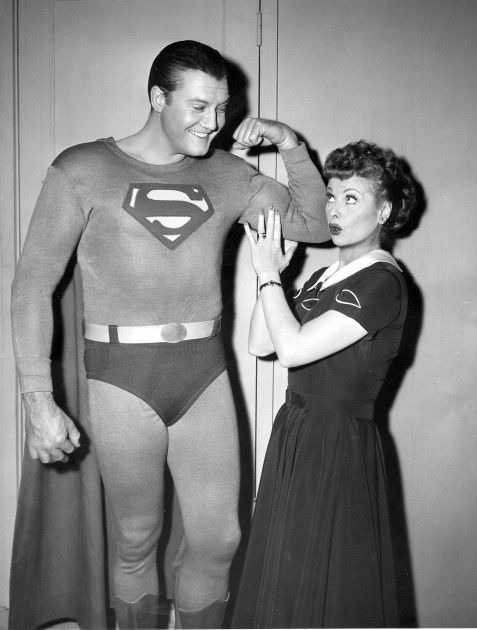
George Reeves was born George Keefer Brewer in Woolstock, Iowa. He is best known for his role as Superman in the television program “Adventures of Superman” (1952-58). His birth date is often listed as April 5, 1914, but that was born only five months after his parents' wedding and it was not until adulthood that he learned the truth. To further confuse matters, his mother made a mistake when having the urn containing his ashes inscribed and it reads January 6 instead of January 5.
Reeves began acting and singing in high school and continued performing on stage as a student at Pasadena Junior College.
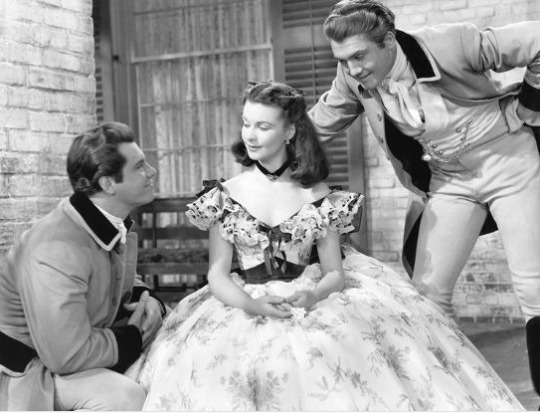
Reeves's film career took off in 1939 when he was cast as Stuart Tarleton (incorrectly listed in the film's credits as Brent Tarleton), one of Scarlett O'Hara's suitors (with Fred Crane, above left) in Gone with the Wind. Reeves dyed his hair red to portray one of the Tarleton twins. Lucille Ball read for the role of Scarlet O’Hara, one of hundreds of Hollywood starlets that vied for the role. References to the novel and iconic film can be found throughout her sitcoms. Had she gotten the part, she would have been in the film with her future “I Love Lucy” actors Olin Howland, Irving Bacon, Alberto Morin, Shep Houghton, Ralph Brooks, and Hans Moebus. Sam McDaniel, brother of Mammy portrayer Hattie McDaniel, would be the first and only person of color to speak on “I Love Lucy” as the Porter in “The Great Train Robbery” (ILL S5;E5). Lucille Ball would one day own the back lot where the movie was filmed!
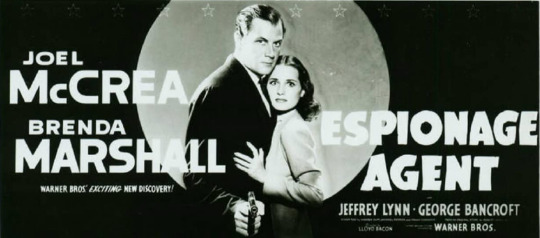
Although Gone With the Wind was his first credited role in a feature film, a Warner Brothers short film titled Ride, Cowboy, Ride and the feature Espionage Agent were actually released three months earlier.
While studying acting at the Pasadena Playhouse in 1940, Reeves married Ellanora Needles, granddaughter of circus magnate John Robinson. They had no children and divorced 10 years later.
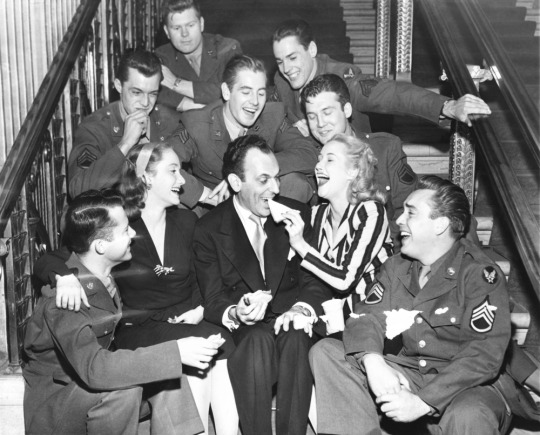
Before his television fame as Superman, Reeves enlisted in the US Army and appeared on Broadway in Winged Victory (1943) by Moss Hart (center). The cast featured actual service members, including Sergeant George Reeves (above, behind Phyllis Avery). He also appeared in the film version.
Reeves made his television debut on September 29, 1949 in an episode (now lost) of the suspense anthology series “The Clock.” Three weeks later he appeared in a second episode.
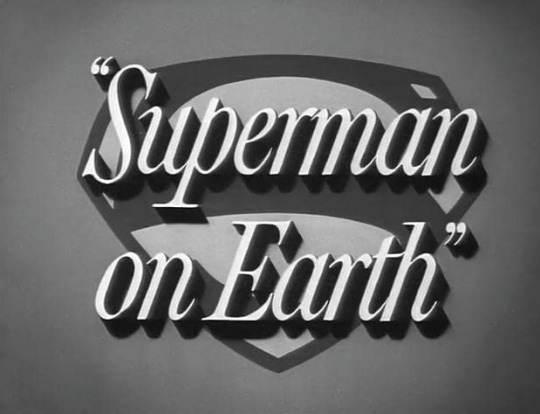
His first episode of “Adventures of Superman” was “Superman on Earth” aired on September 19, 1952. Ross Elliott, who played Ricky Ricardo’s Press Agent on “I Love Lucy”, was cast as Jor-El, Superman’s father, but was replaced by Robert Rockwell, famous for playing Mr. Boynton on “Our Miss Brooks”. Strangely, Elliott still receives screen credit. This first “Superman” also features Dani Sue Nolan, who was the wife of “I Love Lucy” director William Asher. Ironically, Asher did not direct the episode of “I Love Lucy” starring Reeves, which was staged by James V. Kern.
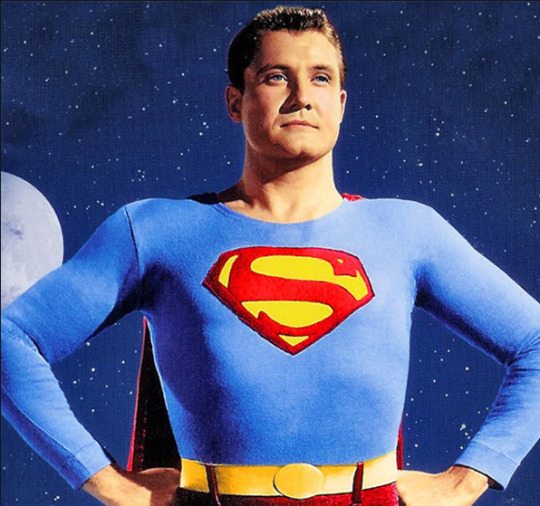
Reeves appeared in all 104 episodes over 6 seasons of the ABC TV series.
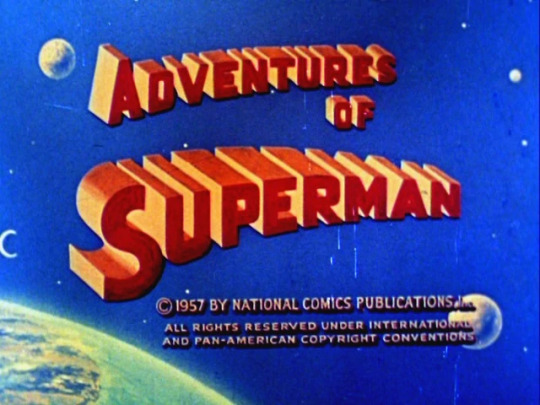
Initially shot and aired in black and white, the series (like “The Lucy Show”) was filmed in color starting with season 3. The first 26 episodes were filmed in 1951, the same year “I Love Lucy” started airing, but did not appear on television until 1952, when Kellogg's Cereals agreed to sponsor the show. Reeves was 44 years old during the filming of the sixth and final season, making him the oldest actor to have ever played Clark Kent / Superman in live-action. Although the Superman costume was padded to make it appear that Reeves had greater bulk, he did most of his own stunts. The first season of the series was shot on the 40 Acres back lot that was part of RKO / Desilu Studios.
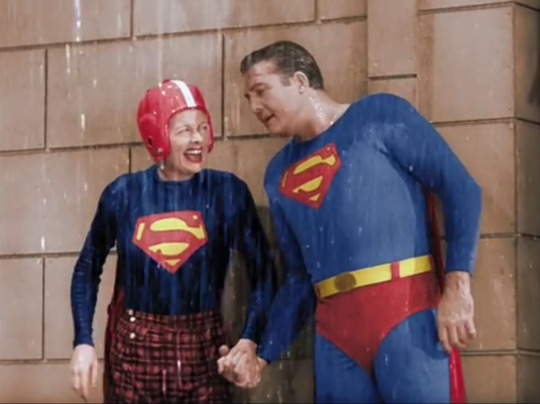
On November 15, 1956, Reeves filmed the now-iconic “I Love Lucy” episode “Lucy and Superman” (ILL S6;E13), which premiered on January 14, 1957. The episode was colorized on May 17, 2015.
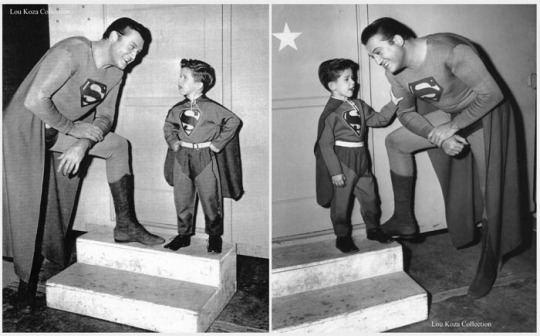
Keith Thibodeaux (Little Ricky) has said that this was his favorite episode of the series. He later talked about meeting Reeves...
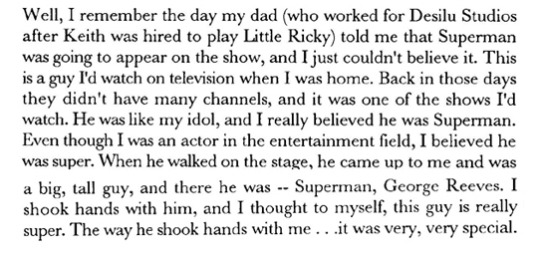
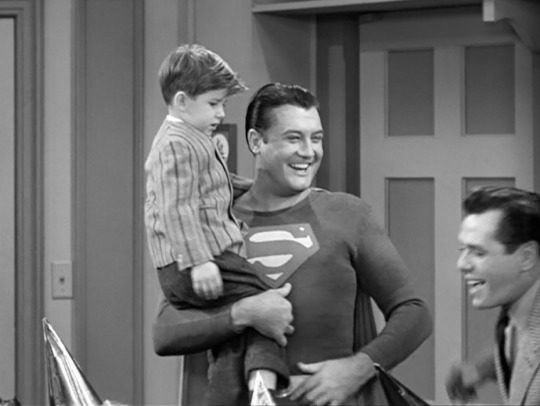
Reeves is never mentioned by name in the dialogue or in the original credits. Lucie Arnaz later theorized that this was in order not to destroy the illusion that Superman was real to the many children who watched the show. In syndication, an announcer end credit was added for Reeve. The logic about the absent billing, however, is odd since Reeves was always credited on his own show.
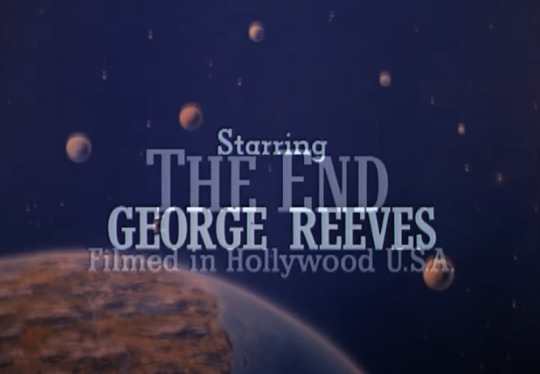
The final episode of the series was also Reeves’ final screen appearance. “All That Glitters” was also directed by Reeves, as were the previous two episodes.
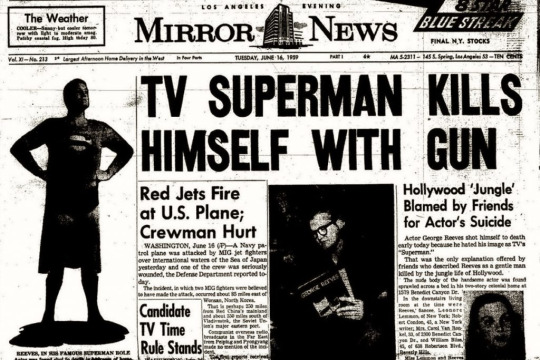
His death on June 16, 1959, from a gunshot remains a controversial subject; the official finding was suicide, but some believe that he was murdered or the victim of an accidental shooting. He was 45 years old.
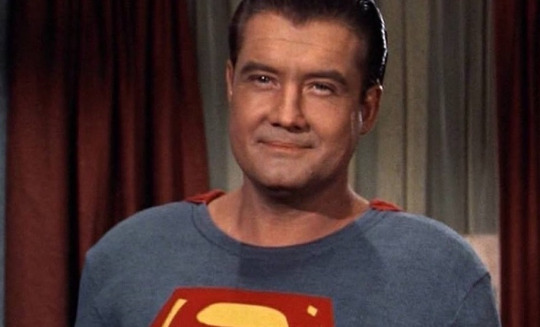
#George Reeves#I Love Lucy#Lucille Ball#Adventures of Superman#Clark Kent#Superman#TV#Keith Thibodeaux#Winged Victory#Moss Hart#Espionage Agent#Gone With the Wind
93 notes
·
View notes
Text
Episode 238 – Jeff Chandler (Part 2)
Jeff Chandler returns to the podcast in another pair of old time radio thrillers. First, he stars in a story set to the lyrics of a haunting ballad in "My True Love's Hair" (originally aired on CBS on October 19, 1953). Then, Chandler is on trial for crimes committed to preserve the anti-Nazi underground in "Death at Skirkerud Pond" (originally aired on CBS on February 8, 1954). Then, he shows off his comedy chops in Our Miss Brooks as Miss Brooks and Mr. Boynton join the Conklins for a weekend getaway (originally aired on CBS on August 21, 1949).
Check out this episode!
3 notes
·
View notes
Photo






Our Miss Brooks, one of the greatest comedies of the Golden Age of Radio, premiered today in 1948. Eve Arden started as the titular English teacher at Madison High School. Every week, Connie Brooks dealt with the pressures of being an overworked and underpaid public schoolteacher with a quick wit and adept sarcastic quips. Whether she was dealing with her school’s martinet of a principal or the zany scheme to boost school spirit, Connie tried to keep her head in a sea of colorful characters.
The supporting cast featured Jeff Chandler (in a role light years away from his ultra hard-boiled take on Michael Shayne) as bashful biology teacher Philip Boynton, the object of Connie’s affections; Jane Morgan as Connie’s kindly but absent-minded landlady Mrs. Davis; Richard Crenna as squeaky-voiced student Walter Denton; and Gale Gordon - the master of the comedic slow burn - as Principal Osgood Conklin. Nearly the entire cast recreated their radio roles in a television series, and the radio program aired until 1957.
With its character-based humor and high school setting, Our Miss Brooks holds up and plays as well today as it did in the 1940s and 1950s.
46 notes
·
View notes
Text
ELLIS IN FREEDOMLAND
Spring 1952

Directed by Abby Berlin Produced by Roland D. Reed Written by Arthur Hoerl Music by Albert Colombo Choreography by Alex Romero
Synopsis ~ A 82 minute, technicolor promotional film for salesmen of Westinghouse appliances, featuring the voices of major Hollywood celebrities. Westinghouse claims its electric appliances "freed women from the drudgery of housework." The first half involves dream salesman Ellis at work; the second focuses on the "Spring Sales Event," called "Freedomland."
Westinghouse Electric Corporation was founded on January 8, 1886 by George Westinghouse (1846–1914). The corporation purchased CBS in 1995.
Live Cast
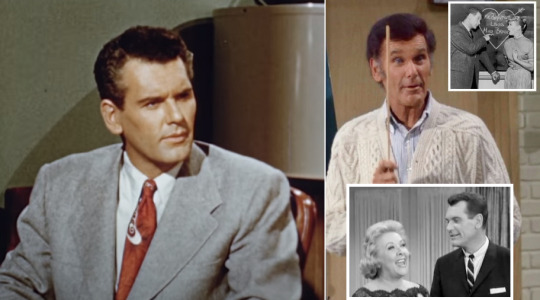
Robert Rockwell (Ellis Homan) is probably best remembered as biology teacher Mr. Boynton on the Desilu series “Our Miss Brooks” (1952-56). Although not the first to play Mr. Boynton, he assumed the role on radio and made the transition with the show to television. He played Viv’s handsome match in “Lucy Digs Up a Date” (TLS S1;E2) the second installment of “The Lucy Show” in 1962. He then played night school teacher Jack Scott in “The Not-So-Popular Mechanics” (HL S5;E23). He continued working until 1995 and died in 2003 at age 82.
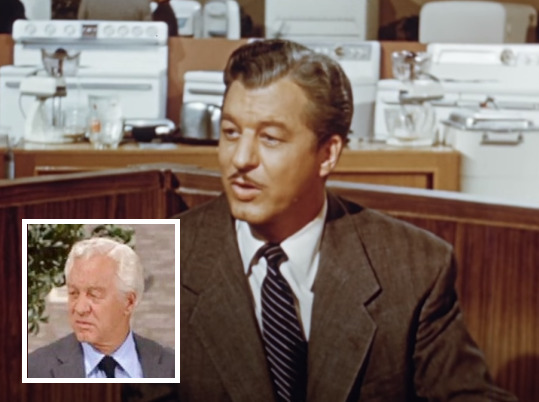
Robert Carson (Phil Pryor, Westinghouse Representative) was a busy Canadian-born character actor who appeared on six episodes of “The Lucy Show” and made five appearance on “Here’s Lucy.”

Byron Foulger (Andy, Night Watchman) played the leader of the Friends of the Friendless in “Lucy’s Last Birthday” (ILL S2;E25). He appeared on “The Lucy Show” in “My Fair Lucy” (TLS S3;E20) and “Lucy Meets the Law” (TLS S5;E19).
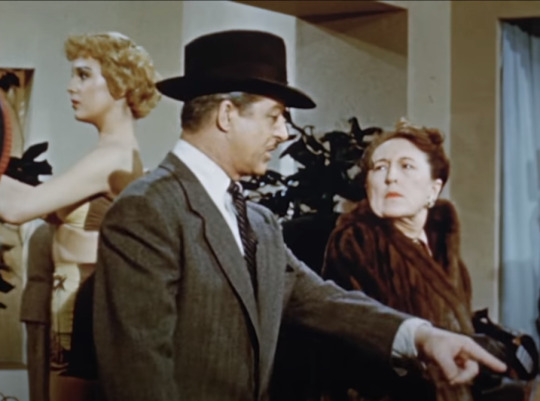
Ann O'Neal (Customer in Mink) appeared in more than 100 films in the 1940s including the Lucille Ball film Lover Come Back (1946).
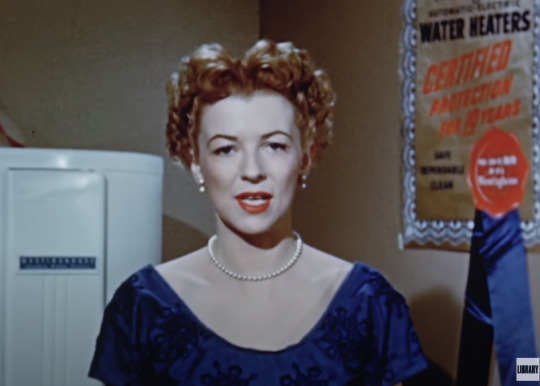
Betty Furness (Herself, Spokeswoman for Westinghouse) was an actress and model who became the face and voice of Westinghouse in many television commercials. When “The Lucy-Desi Comedy Hour” was sponsored by Westinghouse, Furness appeared with Lucille Ball and Desi Arnaz in commercials for their products.
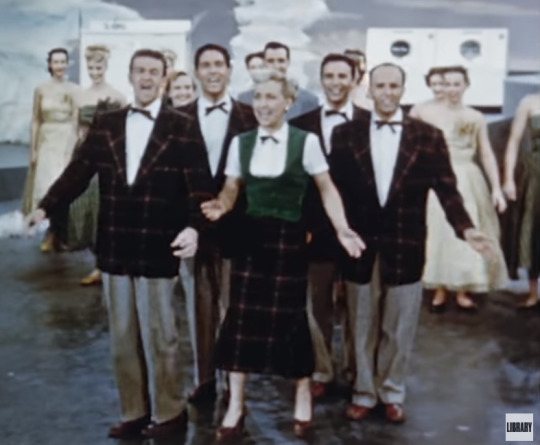
The Starlighters (Vocals) was a singing group that performed mainly as backing vocalists, frequently backing Jo Stafford as well as many other artists on a number of singles. They also performed songs in cartoon and live short films and the feature films Song of Idaho (1948) and With a Song in My Heart (1952).
Voice Cast

Lucille Ball (Lina the Laundromat) was then filming the second half of her first season of “I Love Lucy” playing Lucy Ricardo, although her voice alone was familiar to radio audiences as Liz Cooper in “My Favorite Husband.”
Edward Arnold (Speedy the Range) lends his deep baritone voice to the role. He appeared with Lucille Ball in Roman Scandals (1933) and Ziegfeld Follies (1945). He died in 1956.
James Mason (Frosty the Refrigerator) was a three time Oscar-nominee who appeared as Lucille Ball’s Angel in Forever Darling (1956).
Percy Kilbride (Drip the Dehumidifier) was best remembered as Pa Kettle in a series of films from 1947 to 1954.
Jerry Colonna (Chop-Along Waste-Away the Garbage Disposal) was a comic sidekick of Bob Hope on radio and television. In 1966 he played Smithers, Lucille Ball’s chauffeur on “Bob Hope’s Leading Ladies”.
Andy Devine (Lanky the Water Heater) brought his high-pitched raspy voice to the film. He was known for his many appearances in westerns on both the small and big screen.
Marie Wilson (Dinah the Dryer) is best known for playing the title role in the film and television series “My Friend Irma”. Later in 1952, Wilson and Lucille Ball were both part of “Stars in the Eye” celebrating the opening of CBS Television Center. Coincidentally, Gale Gordon’s mother Gloria was also in “My Friend Irma” and on “The Lucy Show” Mr. Mooney’s off-screen wife was named Irma in her honor.
Maureen O'Sullivan (Pearly the Dishwasher) played Jane in the early Tarzan films. Her career lasted from 1930 to 1994. In 1987, Lucille Ball and O’Sullivan were two of the many stars in “Happy 100th Birthday, Hollywood”.
Mannequins
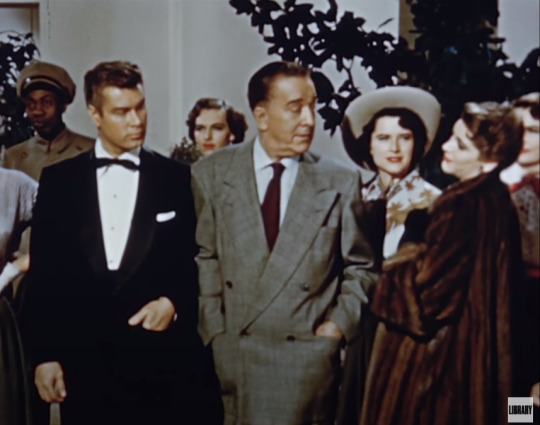
Jack Mulhall appeared with Lucille Ball in Broadway Bill (1934).
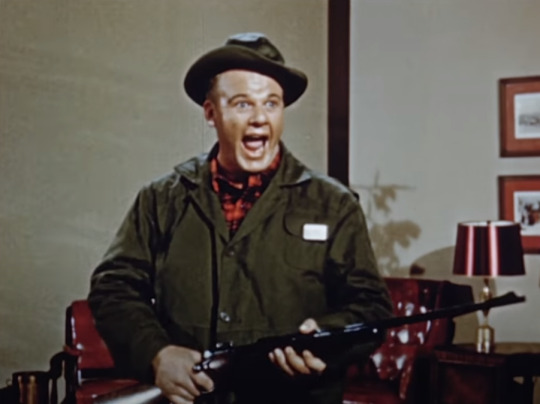
Alan Hale Jr. (Hunter) will forever be remembered as the Skipper on “Gilligan’s Island” but also appeared with Lucille Ball on “The Lucy Show” and “Here’s Lucy”.
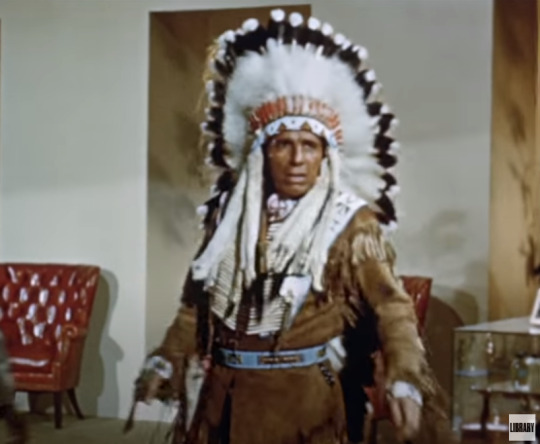
Iron Eyes Cody (Chief Running Water) made a career of playing Native American characters despite the fact that he was of Italian ancestry. He first worked with Lucy and Desi in 1940’s Too Many Girls and 1942’s Valley of the Sun both as an Indian character. He played an Eskimo in a 1959 episode of “The Lucy-Desi Comedy Hour,” but is probably best remembered as the Indian that sheds a single tear in the ‘Keep America Beautiful’ ads that ran from 1971 to the 1980s. He played a Navajo Medicine Man in “Lucy and the Indian Chief” (HL S2;E3).
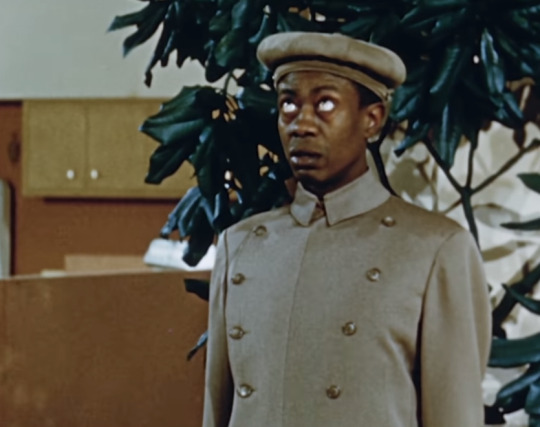
Willie Best (Chauffeur) was one of the most popular African-American actors of Hollywood's Golden Era. He starred alongside some of film's great comedians including the Marx Brothers, Bob Hope, Laurel and Hardy, and three films with Shirley Temple. He did one film with Lucille Ball: Muss ‘em Up (1936).
Karen Sharpe appeared on the “Westinghouse Desilu Playhouse” in 1959.
Mickey Simpson appeared with Lucille Ball in the 1939 film Panama Lady.
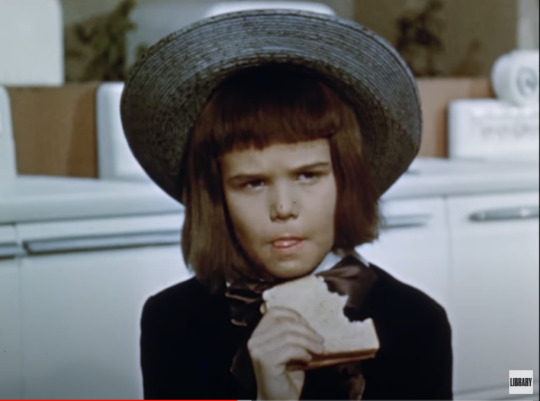
Anthony Sydes (Bobby, the Boy in Buster Brown Outfit) was 8 years old at the time of filming. He left the business in 1958 and died in 2015 at age 74.
With...
Lisa Abbott, Mildred Coles, Richard Crane, Nancy Hadley, Noreen Michaels, Crystal Reeves, Darla Ridgeway, Anne Rubin, Carol Lowe, Frances Zucco
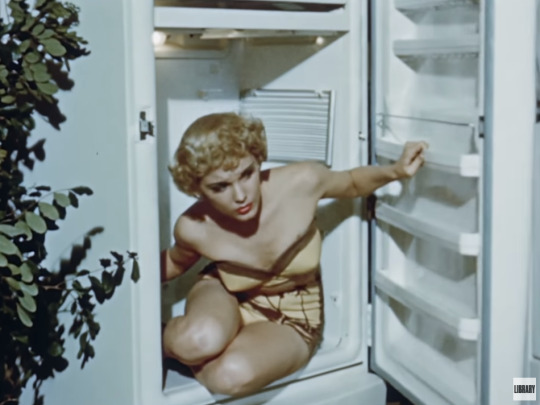
Uncredited Cast
Ralph Brooks (Stove Demonstrator) appeared in four films with Lucille Ball, as well as “The Lucy-Desi Milton Berle Special” and “Lucy Goes to Las Vegas” (TLS S3;E17).
Sam Harris (Showroom Guest) did a dozen films with Lucille Ball before appearing in the audience of Over the Teacups in “Ethel’s Birthday” (ILL S4;E8) and playing a subway passenger in “Lucy and the Loving Cup” (ILL S6;E12). In between, he was a wedding guest in Lucy and Desi’s film Forever Darling (1956). Along with Monty O'Grady and Murray Pollack, he was in the airport when “The Ricardos Go to Japan” in 1959.
Stuart Holmes (Showroom Guest) appeared with Lucille Ball in Lover Come Back (1946) and Critic’s Choice (1963).
Hans Moebus (Washer / Dryer Demonstrator) appeared as an uncredited background performer in hundreds of movies and TV shows, including the Lucille Ball films DuBarry Was a Lady (1943), A Woman of Distinction (1950) and The Facts of Life (1960). He was seen on the dock during the “I Love Lucy” episode “Bon Voyage” (ILL S5;E13) and part of the riverboat chorus in “Lucy Meets Arthur Godfrey” (TLS S3;E23).
Charles Sherlock (Television Viewer) appeared in three feature films with Lucille Ball from 1935 to 1963.
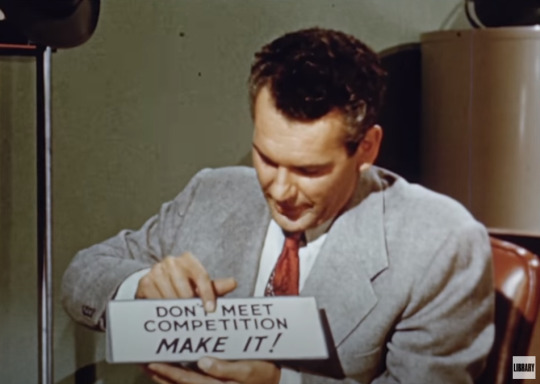
PART ONE - DON’T MEET COMPETITION, MAKE IT!
Westinghouse Rep Phil Pryer meets salesman Ellis Homan at his office on the department store showroom. Ellis tells Phil about the time he dozed off at his desk and the mannequins came to life: menswear, formal wear, beach wear, and (inexplicably) an American Indian in full regalia. Frosty the Refrigerator (James Mason) gets Ellis’ attention to demonstrate his frost-free features, as well as his unique butter tray and meat keeper.
Ellis then has a conversation with Speedy the Electric Range (Edward Arnold) about all its features. Ellis even makes coffee and cookies for Mabel, a mannequin standing in for a ‘prospect’.
MABEL: “Ellis, you’re cute. I wish you were a dummy.”
Ellis then has a chat with Pearly the Dishwasher (Maureen O’Sullivan) and Chop-Along Waste-Away the Garbage Disposal (Jerry Colonna), who sings during his demonstration.
Lanky the Water Heater (Andy Devine) is upset because no one pays him much attention. Pearly draws Ellis’s attention to the drip who has shown up in the showroom lately, the Dehumidifier (Percy Kilbride) who promises to rid homes of damaging dampness.
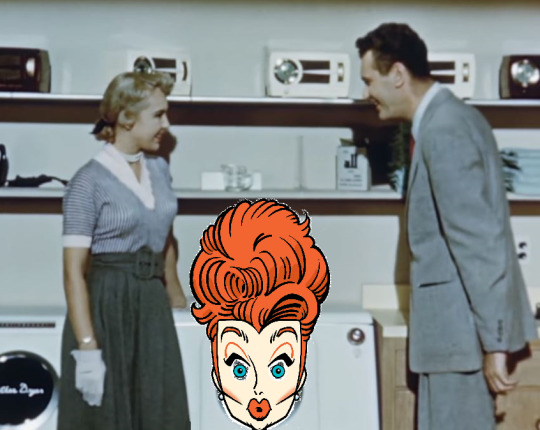
Chiming in (literally) Lina the Laundromat (Lucille Ball) and Dinah the Dryer (Marie Wilson) sing their greeting. Known as ‘The Westinghouse Twins’, they often finish each others’ sentences and speak at the same time - all in aid of showing that they are a perfect freedom-fighting duo in a home. Ellis demonstrates a typical wash cycle.
PART TWO - FREEDOM FAIR
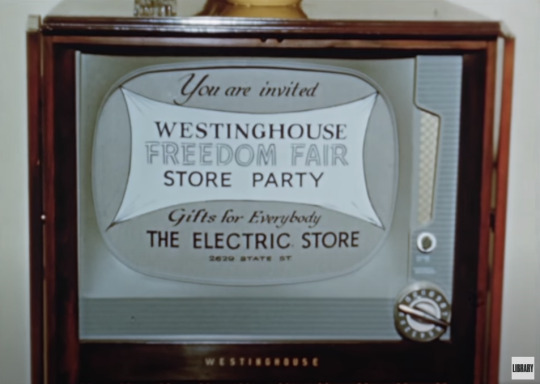
Back in the present, Phil tells Ellis that Westinghouse is sponsoring radio and television coverage of the summer’s 1952 Republican and Democratic conventions, with ‘Get Out the Vote’ programs to follow. In the meantime, Phil tells Ellis about the big Spring Selling Event - Freedom Fair. The event will be rolled out in the April 11, 1952 issue of Life Magazine and the April 16, 1952 issue of the Saturday Evening Post. On television, it will be announced by Betty Furness on “Studio One”.
After Phil leaves, the scene changes to a typical suburban couple’s bedroom where the morning alarm has just gone off. The bedraggled housewife dances through the home trying to get ready for the day ahead - despite the fact that she does not have any time-saving Westinghouse electric appliances. As the harried husband downs a quick cup of coffee and dashes off to work, the song begins (with offscreen vocals by the Starlighters) and the frustrated housewife realizes just how much work she has ahead of her to clean her home. Just then an ethereal voice sings the name “Westinghouse! Westinghouse!” and there is suddenly a handsome young salesman ringing her doorbell. He sings:
“They say that Lincoln freed the slaves, With that I disagree. Women have been slaves for years Till Westinghouse set them free!”
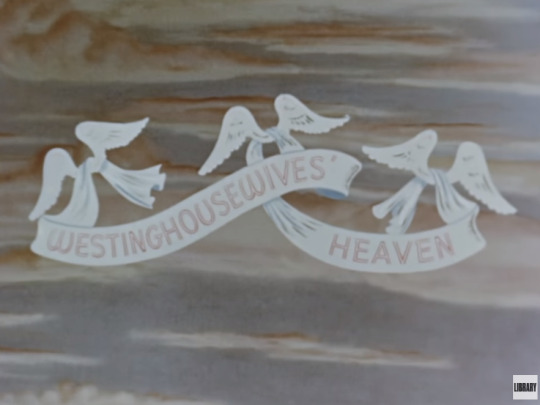
He whisks her away to ‘Westinghousewives’ Heaven’ where all the products we previously saw demonstrated are extolled in joyous song, some even have angel wings! The housewife (still in her curlers and pajamas) ducks behind a cloud and is suddenly revealed in a diaphanous white gown complete with apron! Amid a large group of ballet dancers, the Westinghousewife and Salesman dance in blissful happiness.
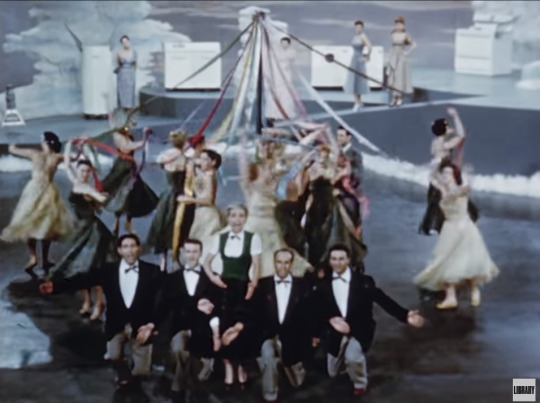
At the last moment the Starlighters appear and sing to us about Westinghouse, while the dancers swirl merrily around the May Pole!
Stereotypes
This film is obviously aimed at a male sales force. All the ‘prospects’ are assumed to be female and referred to in such terms as “the little lady”. The female mannequins are only interested in Ellis as romantic partners. Clearly, housewives were the main target of male salesmen.
The film also presents a stereotypical black chauffeur, the only person of color in the cast. The actor is asked to pull comical faces that make him appear silly - the source of humor
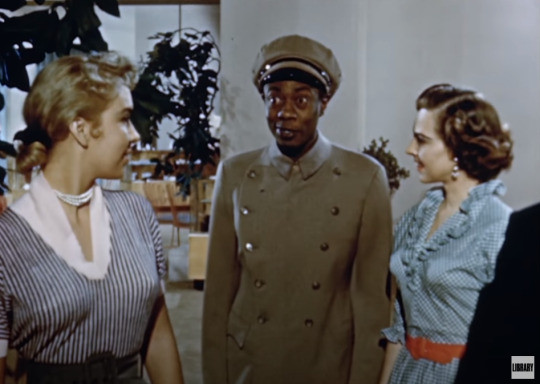
“Mmmm. There’s gonna be a watermelon missin’, ‘round here.”
Needless to say, that an American Indian chasing a scantily clad Caucasian woman around the store plays on stereotypical images of predatory Native Americans. The actor playing the Chief is Iron Eyes Cody, who, despite his name, was born Espera Oscar de Corti, an Italian-American. When trying to communicate all he says is “Ugg!”
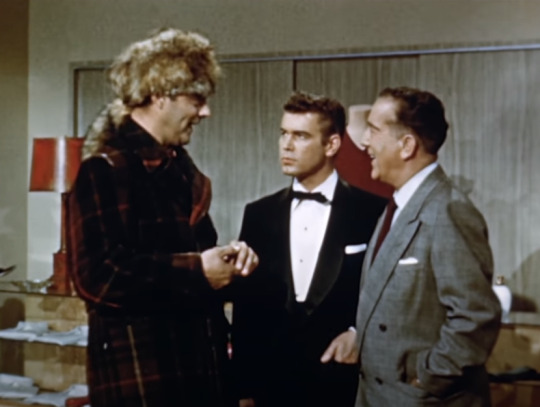
Homosexuals don’t escape either. A man with an effeminate manner and lisping voice wearing a coonskin cap swishes in to say “Hello, Fellas” with a toss of the raccoon tail he swans off. The two men in suits look uncomfortable and deny knowing him.
Voice casting reflects gender stereotypes of the time. Cooling and heating appliances are voiced by men while washing appliances are voiced by women.
Trivia
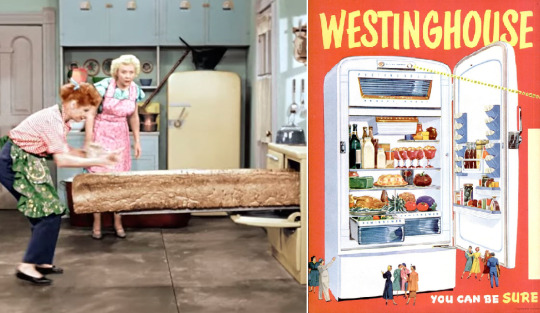
Lucille Ball’s participation in this film may have influenced or been influenced by the fact that for the first season of “I Love Lucy” Lucy Ricardo had a 1951 Westinghouse Frost-Free refrigerator in her kitchen - very similar to “Frosty” - the model shown here in the film. It was widely promoted in print publications and on TV during 1951. Previously, the freezer cabinet had to be thawed manually when frost and ice built up in and around it.
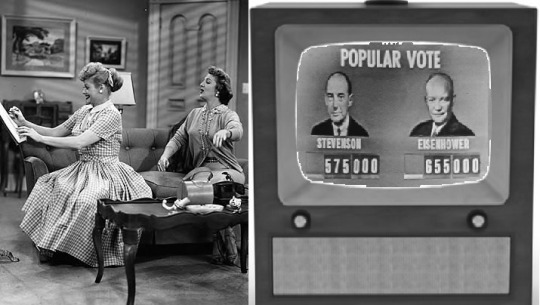
LUCY: “Didn’t you watch the conventions on television?”
Phil tells Ellis that Westinghouse will take out extensive advertising on radio and TV during the Conventions. In July 1952 both the Republican and Democratic National Conventions were televised live from Chicago. Although the conventions were also televised in 1948, few Americans owned a TV set to watch them. This time, an estimated 70 million voters watched the broadcasts, which ended with the nominations of Adlai Stevenson II and Dwight D. Eisenhower. There is a popular myth that Stevenson lost the election because of backlash from interrupting airings of “I Love Lucy” with hour-long campaign ads. Perhaps from Westinghouse? The conventions were mentioned on “I Love Lucy” (appropriately) in “The Club Election” (ILL S2;E19) which aired in February 1953. However, it was filmed in September 1952, when the reference would have been much more timely. By the time it eventually aired, Eisenhower had been inaugurated and the conventions were a distant memory.
Distribution: Who Saw It - The film series reached 25,000 dealers in 75 cities in a single week. Released in Technicolor and in 16mm. Longest of four dealer promotion films in a two-hour series produced to promote Westinghouse home appliances.
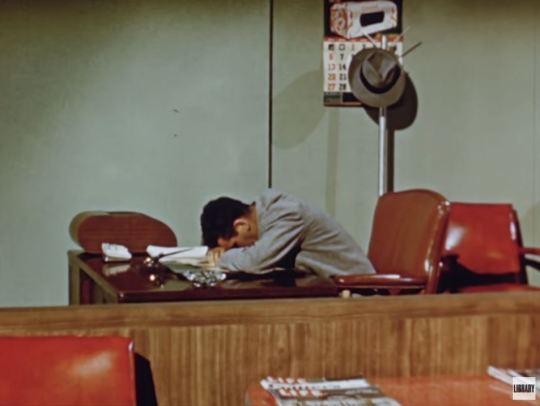
The wall calendar above Ellis’s desk matches the calendar for January 1952, which was likely the filming date. The calendar depicts a loaf of bread with the brand name redacted for filming. On the table close to the bottom of the frame are copies of Life Magazine. Later on, Ellis makes instant coffee from a jar labeled Maxwell House Coffee, although the dish washing detergent and the food in the fridge are obviously props with no brand identification. The laundry soap, however, is clearly labelled ‘All’ but is not in their usual bright colored packaging.
Blooper Alerts!
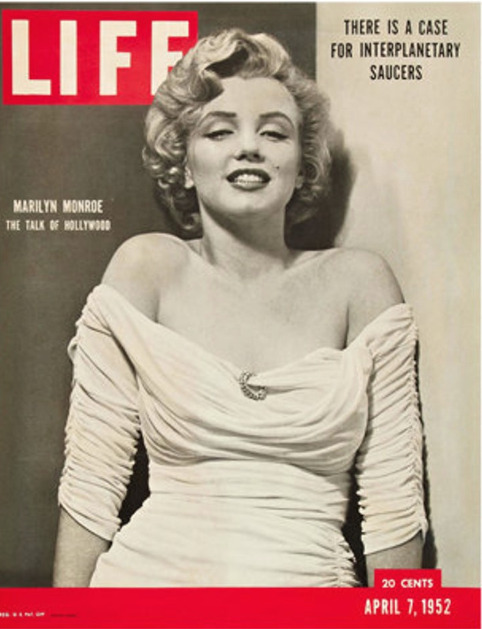

Dates! Phil tells Ellis that Freedom Fair will be announced in the April 11 issue of Life. However, the issue is actually dated April 7, 1952, not April 11. Interestingly, copies of Life Magazine are used as set decoration in Ellis’s office. Similarly, the April 16 edition of the Saturday Evening Post is really dated April 12.
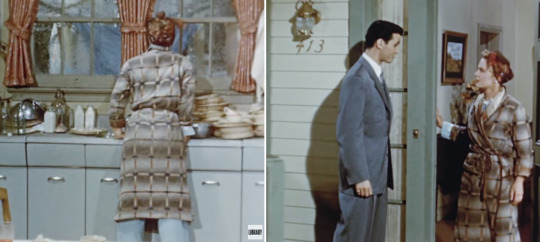
Weather Forecast! The put-upon housewife at the end of the film realizes her wash is still on the line when there is a sudden cloudburst (she does not own an electric dryer). The next moment, she answers the door to the Westinghouse Salesman and it is a clear day. Not really a blooper, just an indication that Westinghouse makes a rainy day into a sunny one - at least in the movies!
Fast Forward!

“Westinghouse Desilu Playhouse” was a television anthology series produced by Desilu Productions. The show ran on CBS between 1958 and 1960. Two of its 48 episodes served as pilots for the 1950s television series “The Twilight Zone” and “The Untouchables.” It also presented 11 of the 13 episodes of “The Lucy-Desi Comedy Hour” after its initial sponsorship by Ford.
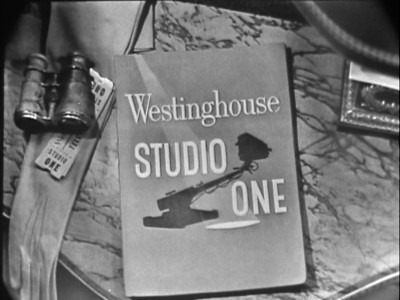
In joining forces with Desilu, Westinghouse canceled their other anthology series “Studio One” which ran on CBS from 1948 to 1958.
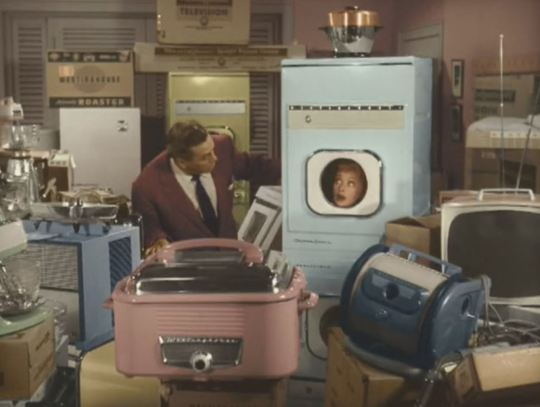
To kick off the partnership between Desilu and Westinghouse, a similar film (informally titled “Lucy Buys Westinghouse”) was produced which depicted Lucy and Desi giving a Westinghouse Executive a tour of their studio, formerly RKO. All through the tour, much to the dismay of Desi, Lucy is trying to order appliances for her dressing room from the executive! At the end, Lucy appears inside a Westinghouse dryer - hiding from Desi! Like Ellis in Freedomland, this film was only shown to Westinghouse employees. Unlike Ellis, it was filmed in black and white - only later colorized for home video. Throughout the film, Desi mispronounces the company’s name as “Westin-Gouse” and its spokesperson as Betty “Furnace”.
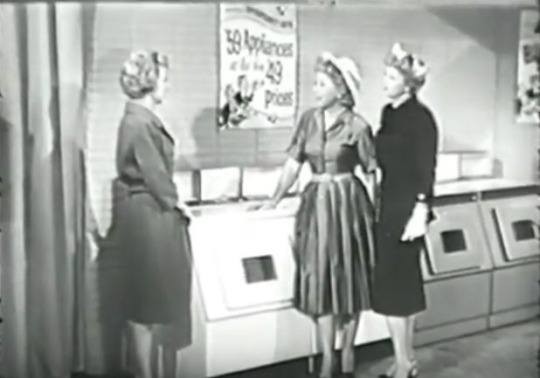
During that time, the cast often did long-form commercials for Westinghouse. Here, Betty Furness and Vivian Vance join Lucille Ball to talk about the 1959 Westinghouse washing machine, the same type of appliance Ball voiced in this film seven years earlier.
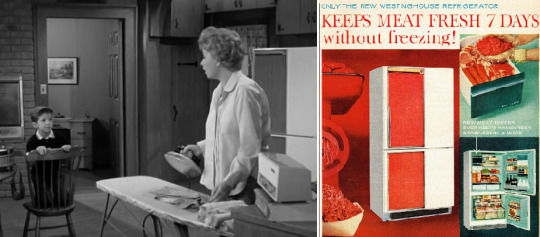
Naturally, during this period Lucy Ricardo had the most up-to-date Westinghouse appliances in her Westport home. Like this two-toned refrigerator and freezer.
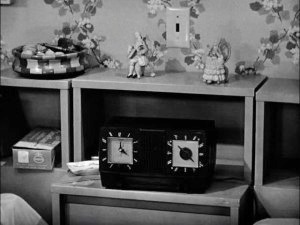
Back in New York City, the Ricardos owned a Westinghouse Clock Radio!
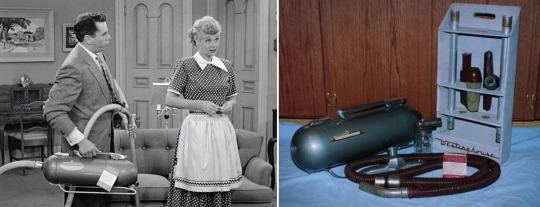
The Handy Dandy vacuum cleaner was actually a Westinghouse model!
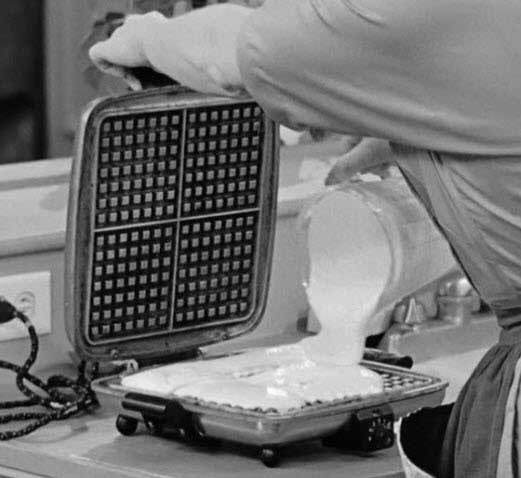
In 1954, Lucy made breakfast with her Westinghouse "Grill-n-Waffler" Waffle Iron - if only she can remember to pay the electricity bill, that is!
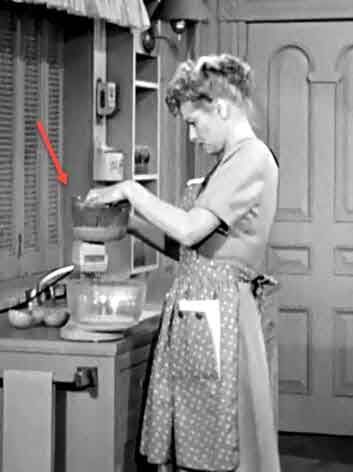
Lucy squeezes oranges for juice with her Westinghouse Model #FM-511 Food Crafter with juicer attachment (sold separately).
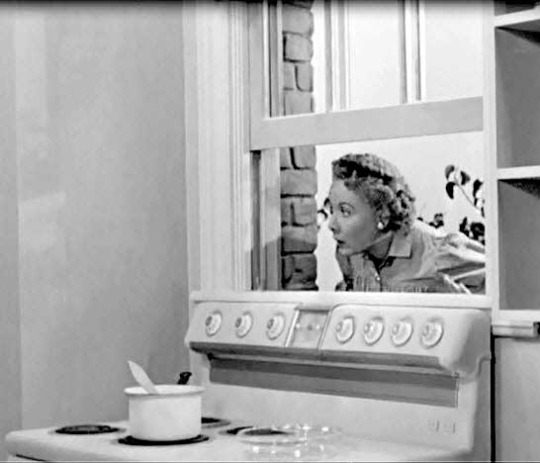
Lucy owned two different models of the Westinghouse Commander Super-Corox Range. This 1950 model was used during season one...
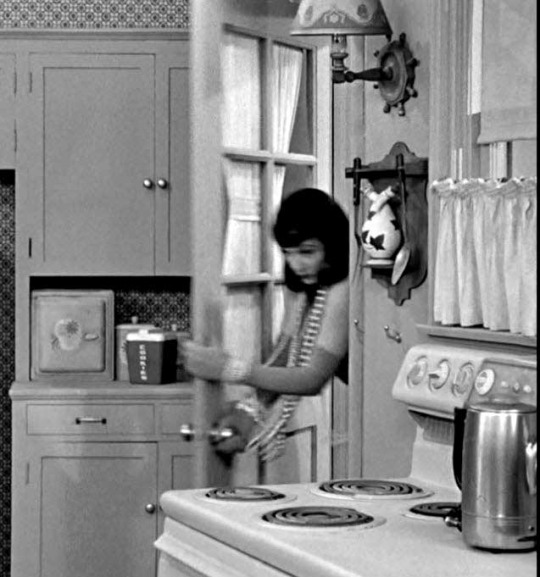
...and this 1954 Model on a later season. It looks similar to the 1950 model, but the controls have a different layout.
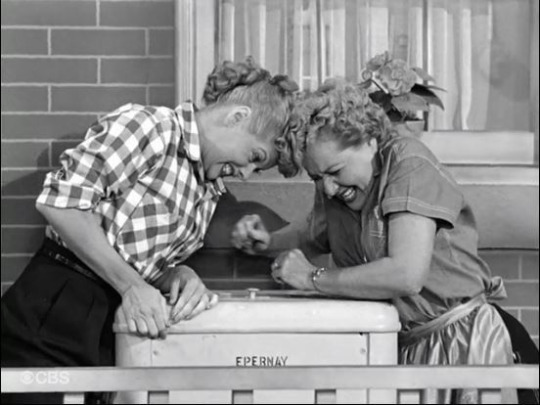
In 1953, ownership of a washing machine was a point of contention between the Ricardos and Mertzes. The appliance used in the episode is labeled Epernay (a fictional brand). In actuality, it is probably a Launderall Horton 500 with gas stove handles affixed to the sides to help move it back and forth on the narrow porch.
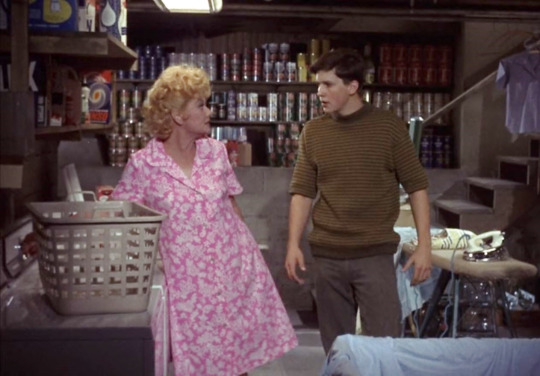
Lucy uses the washing machine (a lot!) in Yours, Mine and Ours (1968). It is impossible to see what brand it is.
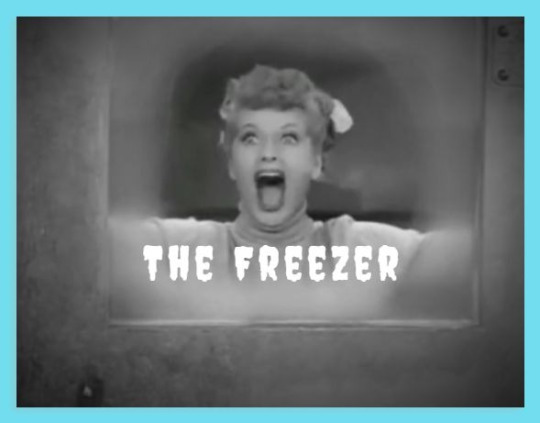
Coincidentally, in April 1952, “I Love Lucy” did an episode titled “The Freezer” (ILL S1;E29) where Lucy and Ethel want to buy a home freezer to economize, but end up buying a walk-in model instead. In Jess Oppenheimer’s book, he states that newspapers and magazines were full of ads for home freezers at the time. Once they came up with the idea of Lucy getting trapped in the freezer, they had to abandon the home freezer idea for a larger, walk-in model.
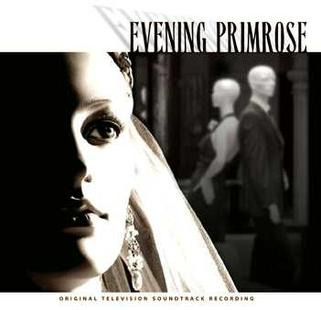
In 1966, a TV musical titled “Evening Primrose” with music by Stephen Sondheim and a book by George Furth, also explored the idea of department store mannequins coming to life. Anthony Perkins starred.
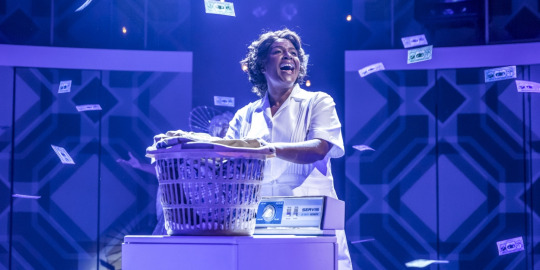
The idea of anthropomorphized laundry room appliances was also explored in the 2004 Broadway musical Caroline, or Change, in which actors played embodiment of the Washing Machine and the Dryer. A revival of the musical was on track for Broadway but interrupted by the Corona Virus pandemic.
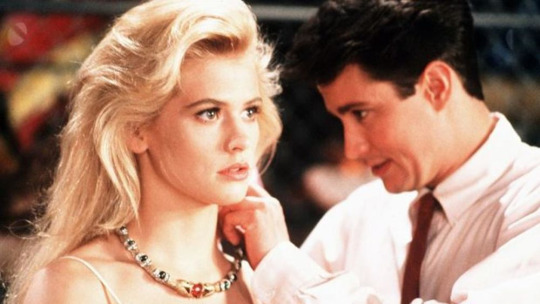
In 1987, the film Mannequin starring Andrew McCarthy and Kim Cattrall also explored the idea of department store mannequin coming to life. It was partly based on the 1948 film One Touch of Venus, although in that film, the mannequin was a statue.
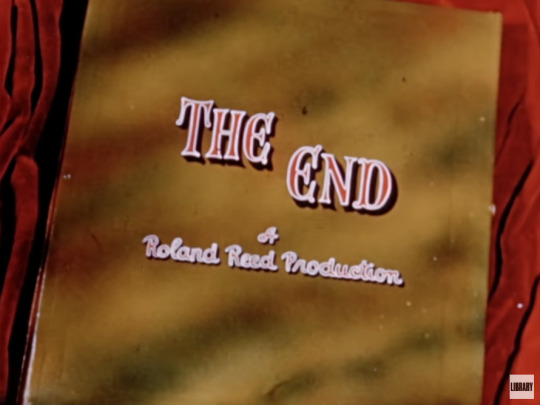
#Westinghouse#Lucille Ball#1952#I Love Lucy#Maureen O'Sullivan#Percy Kilbride#Jerry Colonna#Alan Hale Jr.#Alan Hale#Ellis in Freedomland#Edward Arnold#James Mason#Andy Devine#Vivian Vance#Marie Wilson#Betty Furness#Robert Rockwell#Robert Carson#Byron Foulger#Iron Eyes Cody#Willie Best
9 notes
·
View notes
Text
THE PORTRAIT ARTIST
August 6, 1948
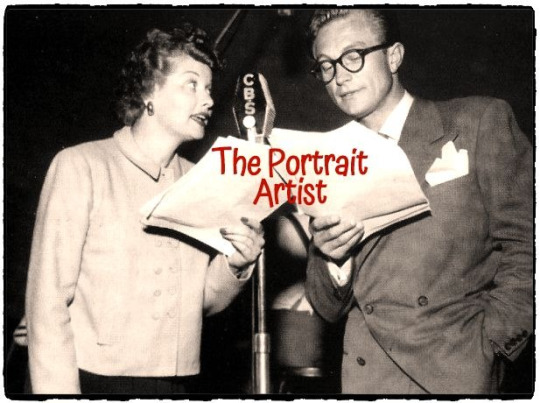
"The Portrait Artist” aka “The Portrait Painter” aka “The Portrait” is episode #3 of the radio program MY FAVORITE HUSBAND broadcast on August 6, 1948 on the CBS Radio Network.
Synopsis ~ Liz is having her portrait painted by a handsome but gruff artist. George gets jealous and fakes illness, and he is attended to by a sexy young nurse - causing the green-eyed monster to rear between both Cugats!
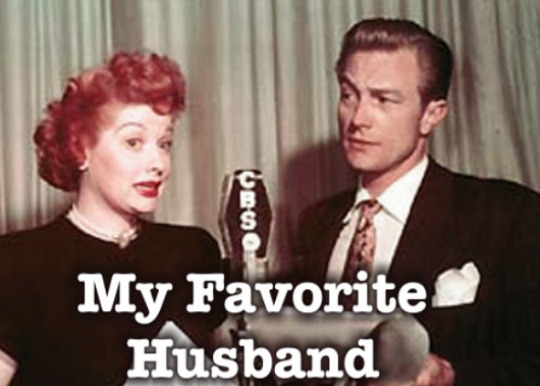
MAIN CAST
Lucille Ball (Liz Cugat) was born on August 6, 1911 in Jamestown, New York. She began her screen career in 1933 and was known in Hollywood as ‘Queen of the B’s’ due to her many appearances in ‘B’ movies. With Richard Denning, she starred in a radio program titled “My Favorite Husband” which eventually led to the creation of “I Love Lucy,” a television situation comedy in which she co-starred with her real-life husband, Latin bandleader Desi Arnaz. The program was phenomenally successful, allowing the couple to purchase what was once RKO Studios, re-naming it Desilu. When the show ended in 1960 (in an hour-long format known as “The Lucy-Desi Comedy Hour”) so did Lucy and Desi’s marriage. In 1962, hoping to keep Desilu financially solvent, Lucy returned to the sitcom format with “The Lucy Show,” which lasted six seasons. She followed that with a similar sitcom “Here’s Lucy” co-starring with her real-life children, Lucie and Desi Jr., as well as Gale Gordon, who had joined the cast of “The Lucy Show” during season two. Before her death in 1989, Lucy made one more attempt at a sitcom with “Life With Lucy,” also with Gordon.
Richard Denning (George Cugat) was born as Louis Albert Heindrich Denninger Jr., in Poughkeepsie, New York. When he was 18 months old, his family moved to Los Angeles. Plans called for him to take over his father's garment manufacturing business, but he developed an interest in acting. Denning enlisted in the US Navy during World War II. He is best known for his roles in various science fiction and horror films of the 1950s. Although he teamed with Lucille Ball on radio in “My Favorite Husband,” the two never acted together on screen. While “I Love Lucy” was on the air, he was seen on another CBS TV series, “Mr. & Mrs. North.” From 1968 to 1980 he played the Governor on “Hawaii 5-0″, his final role. He died in 1998 at age 84.
Ruth Perrott (Katie, the Maid) was also later seen on “I Love Lucy.” She first played Mrs. Pomerantz, a member of the surprise investigating committee for the Society Matrons League in “Pioneer Women” (ILL S1;E25), was one of the member of the Wednesday Afternoon Fine Arts League in “Lucy and Ethel Buy the Same Dress” (ILL S3;E3), and also played a nurse when “Lucy Goes to the Hospital” (ILL S2;E16). She died in 1996 at the age of 96.
GUEST CAST

John Hiestand (Cory Cartwright) served as the announcer for the radio show “Let George Do It” from 1946 to 1950. In 1955 he did an episode of “Our Miss Brooks” opposite Gale Gordon in which he once again had the surname Cartwright.
The role of Cory Cartwright was originated by Hal March but Hiestand very quickly replaced him. March did, however, stay with the show and appears from time time as various characters.
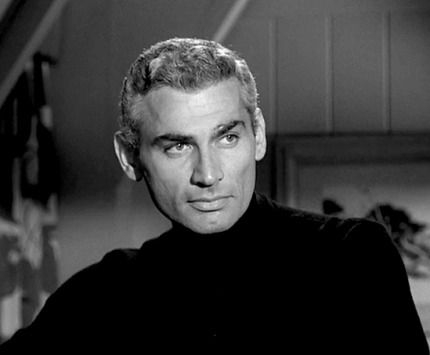
Jeff Chandler (Damon Welch) was known for his prematurely gray hair and striking good looks as a young man. On radio, he was on “Our Miss Brooks” as Mr. Boynton with Eve Arden. When the series moved to television in 1952, Chandler was replaced by Robert Rockwell. Chandler died at age 42 from blood poisoning after an operation.
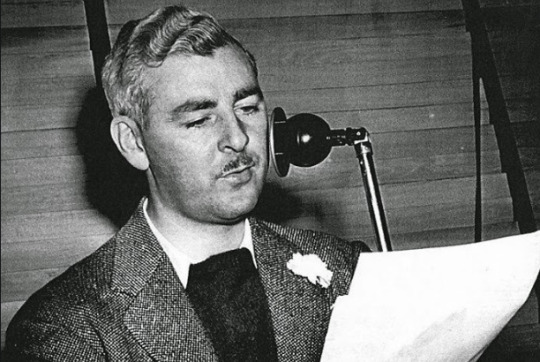
William Johnstone (Doctor) is best known for his voice work as the title character on “The Shadow” from 1938 to 1943, replacing Lucille Ball’s friend Orson Welles. He played John Jacob Astor in the 1953 film Titanic.

Mary Shipp (Nurse Mary Ann McCarthy) was a radio and TV actress and the second wife of CBS Executive Harry Ackerman. Shipp played a recurring character on CBS’s “My Friend Irma” (1954-55) which featured Gale Gordon’s mother Gloria and Hal March, who was the first actor to play Cory Cartwright.

“My Favorite Husband” was based on the novels Mr. and Mrs. Cugat, the Record of a Happy Marriage (1940) and Outside Eden (1945) by Isabel Scott Rorick, which had previously been adapted into the film Are Husbands Necessary? (1942). “My Favorite Husband” was first broadcast as a one-time special on July 5, 1948. Lucille Ball and Lee Bowman played the characters of Liz and George Cugat, and a positive response to this broadcast convinced CBS to launch “My Favorite Husband” as a series on July 23, 1948. Bowman was not available Richard Denning was cast as George. On January 7, 1949, confusion with bandleader Xavier Cugat prompted a name change to Cooper. On this same episode Jell-O became its sponsor. A total of 124 episodes of the program aired from July 23, 1948 through March 31, 1951. After about ten episodes had been written, writers Fox and Davenport departed and three new writers took over – Bob Carroll, Jr., Madelyn Pugh, and head writer/producer Jess Oppenheimer. In March 1949 Gale Gordon took over the existing role of George’s boss, Rudolph Atterbury, and Bea Benaderet was added as his wife, Iris. CBS brought “My Favorite Husband” to television in 1953, starring Joan Caulfield and Barry Nelson as Liz and George Cooper. The television version ran two-and-a-half seasons, from September 1953 through December 1955, running concurrently with “I Love Lucy.” It was produced live at CBS Television City for most of its run, until switching to film for a truncated third season filmed (ironically) at Desilu and recasting Liz Cooper with Vanessa Brown.
This episode aired on Lucille Ball’s 37th birthday, August 6, 1948.
At this point in the series, George and Liz are still named Cugat. Their surname will be changed to Cooper in 1949 to avoid confusion with a famous Latin bandleader. No, not Desi Arnaz - Xavier Cugat! Also, the show had yet to introduce Iris and Rudolph Atterbury, the secondary characters, similar to Fred and Ethel on “I Love Lucy.” The character of Cory Cartwright, a handsome bachelor friend of the couple, will shortly be phased out. He was initially played by Hal March, but here played by John Hiestand.

Marital jealousy and painting were also the subjects of “My Favorite Husband” the CBS television show on November 29, 1955.
THE EPISODE
Announcer Bob LeMond sets up the premise of the series:
Ten years ago the town’s most eligible bachelor, George Cugat, married socially prominent Elizabeth Elliott. The lavish wedding kept the society columns all over the country in copy for weeks. The New Yorker said:
“The bride and groom were dressed with the nth degree of smartness. The best man was a polo pony.”
The Hearst Papers said:
“The bride and groom were dressed handsomely and attracted comments from guest Douglas MacArthur.”
And The Reader’s Digest said:
“The bride and groom were dressed.”

The joke lies in the brevity of the Digest’s comments. The Reader’s Digest was known for their publication of abridged novels, short stories, and articles that could be read in one sitting. Ricky was seen reading the Digest in “Lucy Writes a Novel” in 1954. That same year, a biography of Ball by Eleanor Harris was included in the Digest - condensed, naturally. Ball appeared on the covers in 1990 and 2003.
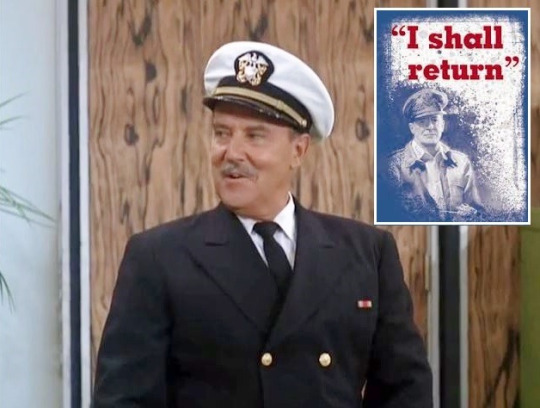
Douglas MacArthur (1880-1964) was a five-star general and Chief of Staff of the United States Army during the 1930s. He played a prominent role in the Pacific theater during World War II. At the time of broadcast, he was running for President of the United States, but was defeated in the primaries by Dewey, who was narrowly defeated in the election by Harry S. Truman. In “Lucy and the Submarine” (1966) Mr. Mooney(Gale Gordon) tells Lucy he’s going on a two-week training, but warns her (in his best deep-voiced, measure tones) that “I shall return!” These were the immortal words spoken by MacArthur when he escaped the Philippines after being surrounded by the Japanese in March 1942.
It is morning at the Cugat home and while George is having breakfast, Katie the maid is trying to help Liz fit into a tight-fitting and slinky evening gown in preparation for having her portrait painted. Katie suggests wearing a different dress for the portrait, but Liz is worried that they might move to Boston one day, and she doesn’t want her portrait banned!

"Banned in Boston" was a phrase employed from the late 19th century through the mid-20th century, to describe a literary work, song, motion picture, or play which had been prohibited from distribution or exhibition in Boston, Massachusetts. During this period, Boston officials had wide authority to ban works featuring "objectionable" content, and often banned works with sexual content or foul language. In 1944, just a few years before this broadcast, Boston banned the book Forever Amber by Kathleen Winsor, which was referred to on “I Love Lucy” as Forever Ember.
Liz goes down to breakfast in her slinky evening gown and tells George that she is having her portrait painted by noted artist Damon Welch.
LIZ: “They say he’s very big and strong and muscular like, uh...who’s that rugged tall actor in the movies? The one with the big arms and broad shoulders?” GEORGE: “Marjorie Main.” LIZ: “No, Victor Mature.”
Marjorie Main (1890-1975) was a character actress who just a few months before this broadcast earned an Oscar nomination for The Egg and I. In 1954 she was a supporting player in Lucy and Desi’s The Long, Long Trailer (1953).

Victor Mature (1913-99) was a stage, film, and television actor who starred in several movies during the 1950s, and was known for his dark hair and smile. Mature and Lucille Ball acted together in Seven Days Leave (1942) and Easy Living (1949).
Bachelor Cory Cartwright (John Hiestand) visits the Cugats with exciting news about his date last night:
CORY: “She had a smile like Lana Turner, a voice like Dinah Shore, she kissed like Paulette Goddard.” LIZ: “Do you date her or buy tickets to her?”

Lana Turner (1921-55) achieved fame as both a pin-up model and a film actress. In the mid-1940s, she was one of the highest-paid actresses in Hollywood and one of MGM) biggest stars. In 1943, she did a cameo in Lucille Ball’s Du Barry Was a Lady. Turner was mentioned in three episodes of “I Love Lucy.”
Dinah Shore (1916-94) was a singer, actress and television personality, as well as a top-charting female vocalist of the 1940s. She achieved even greater success on television, mainly as hostess of a series of variety and talk programs, although she guest starred on “Here’s Lucy” in 1971. Ball made numerous appearances on Shore’s talk shows as well.
Paulette Goddard (1910-90) was major star of Paramount Pictures in the 1940s. She was nominated for an Academy Award for Best Supporting Actress for her performance in So Proudly We Hail! (1943). She did three films with Lucille Ball between 1933 and 1934: Roman Scandals, The Bowery, and The Kid.
George comes home from work and asks Liz about progress on the portrait. Liz was impressed by Welch’s world experience. George feels inadequate. He makes her tell him how much she loves him.
LIZ: “Hold me tighter. Make believe I’m a tube of toothpaste and pop my cap off!”
Dejected that Liz wants him to take up painting like Damon Welch, George goes to bed without his supper.
The second act begins with George deciding to stay home, pretending to be sick in order to keep an eye on Liz and Welch. Katie admits Damon for their sitting. Welch doesn’t believe George is sick.
DAMON: “You should get out-of-doors; do some exercises. Run the mile, do some chin-ups, push-ups, chop some wood, mow the lawn, pull some weights...” LIZ: “Tote that barge, lift that bale!”

Liz chimes in with lyrics from the song “Old Man River” by Oscar Hammerstein II and Jerome Kern, written for the 1927 musical Show Boat. A revival of the musical ran on Broadway in 1946. There was a radio adaptation in 1944. In “Never Do Business With Friends” (1953), Lucy Ricardo analogizes her housework without an electric washing machine to that of the slaves who sing “Old Man River”:
LUCY: “Carrying this heavy basket - up and down, up and down. My muscles straining, body all aching and racked with pain. Fold those shirts, lift those sheets.” RICKY: “Now, look, Old Man River, will you dry up?”
The doctor arrives and examines George, finding nothing whatever the matter with him. His diagnosis is extreme jealousy-itis. He summons his new nurse, Mary Ann McCarthy (Mary Shipp), whose beauty stops George in his tracks.
Downstairs, Liz is still being painted by Damon, but not nearly fast enough for her liking. She complains that he still hasn’t painted her hair! She doesn’t like seeing herself bald!
LIZ: “I look like my mother was frightened by Guy Kibbee!” MONTY: “I’ll paint in your hair when I see fit, and not a second sooner. Until that time you’ll remain an egg-head and like it!”

Guy Kibbee (1882-1956) was a stage and film actor. In the 1935 film Mary Jane's Pa, Kibbee prepares a breakfast dish which consists of a hole cut out of the center of a slice of bread, and an egg cracked into it, all of which is fried in a skillet. It became known as Guy Kibbee Eggs but is also known as eggs in a basket. Liz is no doubt comparing her bald head on the canvas with the eggs. I didn’t hurt the comparison that Kibbee was also bald! Kibbee appeared with Lucille Ball in Don’t Tell The Wife (1937) and Joy of Living (1938).
George hears Damon and Liz laughing and comes downstairs to confront them but Damon sends him back upstairs. Liz wonders if George is jealous just as George is heard laughing upstairs with Nurse McCarthy. Liz goes upstairs to confront her husband! George says he’s had a relapse!
GEORGE: “I accidentally plugged my electric heating pad into the radio and H.V. Kaltenborn got into bed with me!”

Hans von Kaltenborn (1878-1965) was a radio commentator who was heard regularly on the radio for over 30 years, beginning in 1928. He was known for his highly precise diction, his ability to ad-lib, and his knowledge of world affairs. In 1948, Kaltenborn played himself in The Babe Ruth Story which co-starred William Frawley (Fred Mertz).
George, still suspicious of Liz and Damon, goes downstairs to discover that Liz has dismissed the painter so George wouldn’t be sick and Miss McCarthy would go.
After a message from the announcer about participation in community projects (a post-war endeavor), George and Liz engage in some bedtime repartee before they kiss and say goodnight. End of episode!
#My Favorite Husband#Lucille Ball#Richard Denning#Radio#1948#The Portrait Artist#Ruth Perrott#John Hiestand#H.V. Kalenborn#Guy Kibbee#Old Man River#Paulette Goddard#Dinah Shore#Lana Turner#Marjorie Main#Victor Mature#Banned in Boston#Forever Amber#Douglas MacArthur#Reader's Digest#Bob LeMond#Jeff Chandler#Mary Shipp#William Johnstone
2 notes
·
View notes